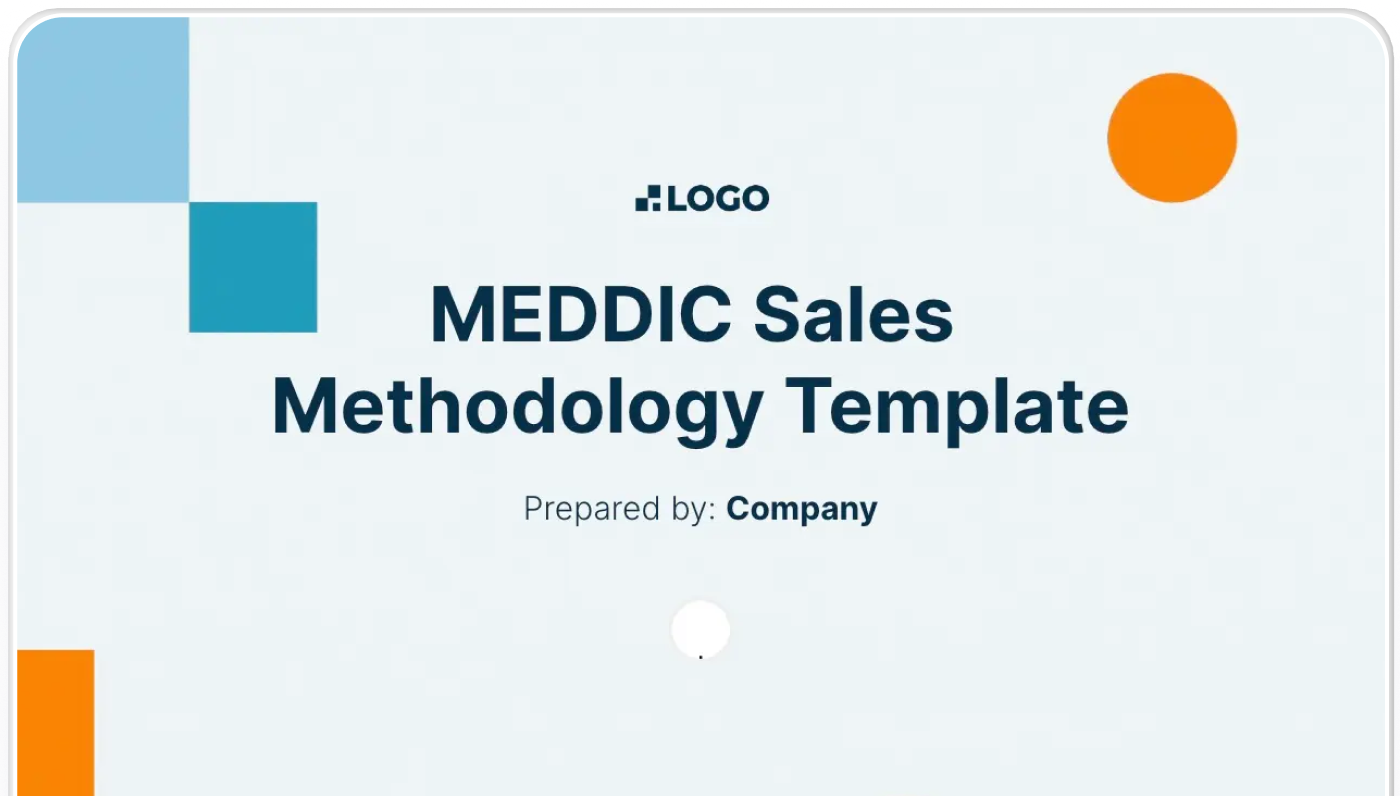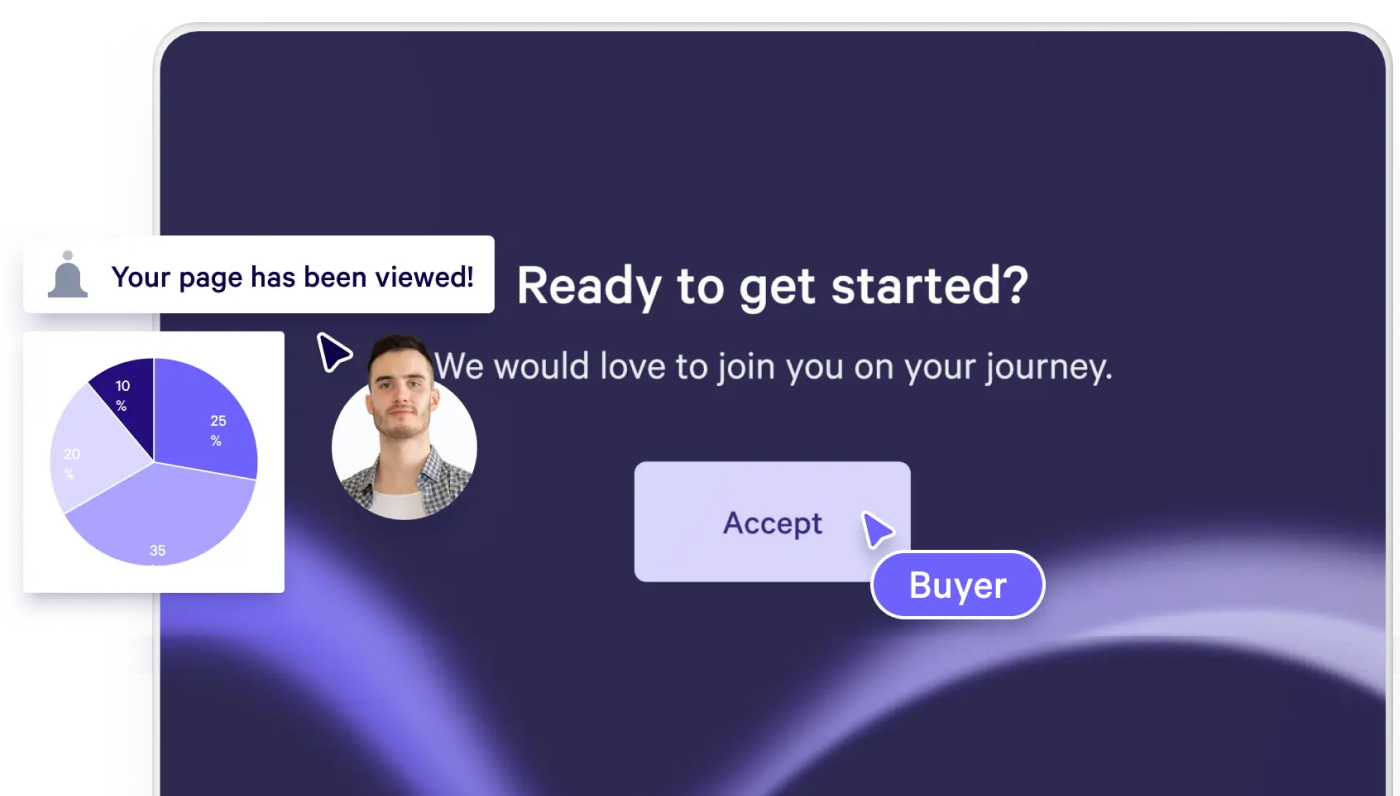
Achieving success in sales goes beyond just securing quick wins; it’s about crafting a sales strategy that grows and adapts with your customers, market, and products. Enter MEDDIC—a highly esteemed sales methodology that provides a solid framework for qualifying new business and advancing opportunities towards closed won revenue.
This strategic approach empowers reps to deeply connect with prospects, accurately meet their needs, and seamlessly guide them through the decision-making process. Let's dive into the core elements of MEDDIC and discover how you can weave it into your sales strategy for repeatable success.
Why is qualification so important?
Qualifying an opportunity using a framework like MEDDIC can help sales teams save time and focus on the deals that are most likely to move forward. By following the MEDDIC framework and gathering all of the necessary information, sales reps can identify and prioritize the deals that are most promising.
Imagine you’re mid-qualification and uncover that a key decision-maker at your prospect's company has a strong preference for a competitor's product and has personal connections there. Without MEDDIC, this might have been realized only after investing significant time in calls and presentations. However, MEDDIC saves you these precious hours by guiding you to disqualify such low-potential opportunities early on.
On the other hand, consider a scenario where during the qualification process, you learn that your prospect is actively searching for a solution, has a substantial budget allocated, and a key stakeholder has previous positive experiences with your product. The MEDDIC framework helps you recognize this as a high-potential deal, prompting you to invest your efforts wisely.
What is the MEDDIC sales methodology?
Calling MEDDIC a sales methodology is a bit of a misnomer. It’s really the framework or sales qualification methodology used to qualify opportunities and, generally speaking, can help drive the early stages of an organization’s sales cycle.
MEDDIC is an acronym that stands for:
- Metrics: How do you measure the value you bring to your clients?
- Economic Buyer: Who is the person with the purchasing authority in your client or prospect’s organization?
- Decision Criteria: What are the benchmarks, features, or other criteria used to make a purchase decision?
- Decision Process: What process does the organization go through to make the decision? How (and when) will a prospect evaluate a product or service?
- Identify Pain: What is the pain point that the prospect is looking to address with your solution?
- Champion: Who is the person (or group of people) internally advocating for you and your product or service?
The MEDDIC sales method has sellers go through each step and uncover critical information about the deal. This methodology was developed back in the early 1990s by Jack Napoli and Dick Dunkel when they were working at PTC. They were able to use this framework to take their sales annual sales from $300 million to $1 Billion in four years– which was a huge economic benefit to PTC.
MEDDIC VS MEDDPICC: How is it different?
Think of MEDDPPICC as MEDDIC 2.0. The additions to the acronym are P for paper process and C for competition.
Paper process comes from the need to better document contractual obligations. In the 90s, when MEDDIC was first invented, the buying process (especially for b2b sales of technology) was much simpler. Sales reps didn’t need to worry about keeping track of contractual obligations that could impact the organization’s bottom line. While this process is now likely handled using CRM or CLM (contract lifecycle management) software, it is still called the paper process in MEDDPICC.
Competition was added because of the increasing competition, especially in the marketing technology area. Today, new Martech companies are popping up at a rate of about five per day, and with the advent of no-code technology, new SaaS companies (not just Martech) coming into the markets will be even more prevalent.
Some other terms like Partners (another “P”) and Compelling Event (another “C”) can also be used in MEDDPICC - which just shows how adaptable the framework is and how it can be adjusted based on factors like the industry trends or evolving business needs.
How to implement MEDDIC into your organization
If you’re looking to implement MEDDIC into your organization, you need to ensure everyone is onboard and speaking the same language. Samantha Lancashire, the Chief Everything Officer of Creating Lightbulb Moments, a sales enablement consultancy, emphasizes this point when thinking about getting started. She says,
“Get the whole of the GTM, including teams that support sales and pre-sales, to utilize the framework - having a common language is very beneficial when hand-offs are required between teams and departments that play a role in completing a sale.”
And when she talks about the whole team, she also means the organization’s senior leadership. She says,
“Ensure senior leadership team members are also MEDDICC ambassadors in their messaging, communications, and expectations. This increases visibility and adoption.”
Before you can implement MEDDIC, you need to teach your sales reps how to find and address each factor that makes up the acronym.
Metrics
The metrics that a potential buyer uses to quantify the value of your solution can vary from organization to organization. According to the MEDDICC organization, there is one rookie mistake many sellers make when aligning their Metrics to the value proposition of their solution. They say that sellers think, “Everyone knows my solution is most commonly used for driving increases in conversion rate, so a Metric for my customer must be increased conversion rate.”
By going deep in the discovery process, sellers can understand the fullest extent of the organizations’ pain points and the value their solution can actually bring. While, in the example above, an increased conversion rate may be of value to a prospect, the real value in the solution may be that their customer success team can focus on higher-value activities and help more customers grow in their use of the solution.
Economic Buyers
Like Miller Heiman Strategic Selling (Blue Sheet) the economic buyer is the person in an organization with the overall authority in the purchase decision. How does a sales rep know if they’ve found the economic buyer? The person can say no to the deal when everyone else on the buying team says yes. They can also say yes to the deal when anyone (or everyone) else says no.
- If you need a few other ways to tell you’re dealing with an economic buyer, find out if the person:
- Has P&L responsibility for the organization or their functional area
- Has access to unrestricted funding or discretionary budget
- Is the person who will ultimately sign the contract when the deal closes
Decision criteria
In some cases, like when responding to an RFP (Request for Proposal) or formal bid request, as is common in larger companies when making big purchases, decision criteria may be clearly spelled out for the sales rep or sales team. But, if you’re doing proactive outreach, you might have to do some detective work to understand your prospect’s decision-making process.
Even when the prospect’s needs seem obvious, and the salesperson has created a solution to address them, it’s still important to understand all of the elements of the decision criteria. This could include the return on investment, pricing, contract terms, or even how the solution will be rolled out in the customer’s organization. Not understanding if these elements are part of the decision criteria can result in the prospect’s final decision going to another solution.
Decision process
Once the sales team or salesperson knows how the deal will be measured, it’s important to understand the decision-making process and any approval process the buying team will follow. When learning about the decision process, salespeople should seek to understand the time frame for making a decision, who will be involved (decision makers), and how they will conduct their evaluation.
If the buying decision is a big one, there may be a lot of people involved in the decision process, which can lead to a longer sales cycle. If the salesperson learns this is the case, they should plan appropriate and regular follow-up during the decision-making timeframe as part of their sales strategy.
Identify pain
As part of the lead qualification process, salespeople need to identify pain (or validate it). Selling a solution to a problem that a prospect doesn’t have generally won’t result in a closed deal.
MEDDIC today talks about three main kinds of pain. They are:
- Financial Pain
- Efficiency Pain
- People Pain
Champion
The champion is someone in the customer’s organization who is internally selling or strongly advocating for you and your solution. While this person might be obvious, as in they’re the one that contacted you in the first place or they’re vocally supportive in meetings, there are some other ways to find out if you have a champion or if your champion has enough power and influence in their organization to help you move the deal forwards.
How MEDDIC can help potential customers too
While MEDDIC is clearly a sales qualification framework, it can also save prospects time and the effort of going through a sales process for a solution that doesn’t fit.
Because the MEDDIC framework is so focused and helps the sales professional to do a deep discovery process before moving into a sales presentation or writing a proposal, it also saves the potential buyer from having to go too far into the sales process before learning that a product or solution isn’t the right fit.
So, while the MEDDIC process is really designed for the seller, it has some quantifiable benefits for buyers.
Continual learning & getting MEDDIC to stick
The reason we always hear the expression, practice makes perfect is because it’s true. As with any new (or new to you) methodology, it takes practice to feel comfortable and get good at using it. MEDDIC is no different. And not only do sellers need to practice, but sales leaders and other executives in the organization need to as well to ensure everyone is using the framework.
Sales training, in general, is not a one-and-done but something that should be prioritized over the course of the fiscal year. While some classroom training or even certification can be extremely beneficial, don’t underestimate the day-to-day opportunities for on-the-job learning.
Ken Millard, an Experienced Enablement Professional and member of the Sales Enablement Collective, says,
“MEDICC must become the language and context of the deal.”
He further explains that you should not expect sellers or sales managers to fully adopt the methodology without support from sales enablement (if your organization has this function).
In his work rolling out MEDDIC, he uses the three Ps — Push, publicize, and pander. Push the teams to adopt, publicize early adopters and early successes, and pander to those laggards (a little). This way, they will start to come around when there is momentum.
Effective MEDDIC Questions To Use
Uncovering the information needed to qualify a prospect using MEDDIC means being a bit of a detective. Asking the right questions at the right time will help sales reps get the information they need or determine that the deal won’t move forward, no matter how good the pitch is. In order to uncover the key details, here are some questions successful MEDDIC sellers ask. Many of these questions may come up naturally in the discovery call; others may have to wait until a little later in the sales process.
What success metrics are you currently using?
This question clearly focuses on understanding the metrics that the organization will use to define the value of your solution. If your prospect is unsure or you feel (based on your experience) that there are metrics they aren’t considering but should - asking follow-up questions and sharing other metrics they might want to consider may be helpful in this discussion.
Who makes the final decision on purchases in your organization?
This question will help you identify the economic buyer. If the prospect you’re speaking with rattles off a list of names of colleagues who will be part of the buying group - you might want to press a bit more. Your goal is to find out which person is the one with the final say over the entire group. While you want to try to ensure everyone is on board with the purchase decision, it’s really the economic buyer you want to be concerned with, so keep trying to identify that person.
What does the final decision maker need in order to be able to sign off on a purchase?
This question speaks to the decision-making process. As a sales rep, you should be looking to understand what information you need to provide, if a formal presentation is required, and what the negotiation process will look like. Essentially, the answer to this question should give you a good idea of how to close the deal.
What are the most important decision criteria for us to meet?
If the decision criteria are not spelled out clearly in an RFP (request for proposal document) shared by the prospect’s organization, you might need to ask them to provide them. By gaining a clear understanding of decision criteria, you’re able to determine if your solution meets the needs of the organization. If it does, you have a good shot of crafting a winning proposal. If your solution does not meet the needs of the organization, you’re able to let them know and move on to a prospect that is a better fit.
Can we review the decision making process and timeline?
Like understanding the decision criteria, understanding the process, and who is involved can make the sales process go much more smoothly. If the prospect has a clear process and timeline, it can be aligned to tasks in your CRM, and you can set reminders for yourself or even automate some of the steps where possible.
Would you mind walking me through the issue and how you’ve attempted to resolve it?
This question and the prospect’s response can help the rep identify pain - both the obvious issues and any others that may have come up in previous attempts to resolve it. If the sales rep is able to uncover pain from previous attempts at resolving the pain that had failed, they can also use this data to overcome (or get ahead of) potential sales objections.
Can you help me get...?
Asking a prospect for data, access to systems, or key decision makers can help reps identify their champion. If a person denies these requests or brushes them off, they’re likely not the champion in the organization. Reps may need to ask these questions to a few people on the buying team to determine who the champion is (and if they have one on the team at all).
Looking to explore MEDDIC right away? Get started with Qwilr’s MEDDIC proposal template.
FAQs
What companies use MEDDIC?
Many well-known companies use MEDDIC to qualify opportunities. These organizations include Qualtrics, Medallia, VMWare, Cisco, Microsoft, Oracle, and Google.
What is the difference between BANT and MEDDIC?
BANT is another acronym that stands for Budget, Authority, Need, and Timeline. It is best used for opportunities with a shorter, more straightforward sales cycle when a rep needs to qualify a lead quickly. On the other hand, MEDDIC is superior for longer sales cycles because it is a bit more comprehensive in the information that the sales rep gathers through the process.
What is gap selling vs. MEDDIC sales?
Gap selling is a sales methodology that helps with discovering a customer’s current state and gradually moving them to their desired state (closing the gap between the two). MEDDIC is a methodology designed to help sales reps close the right deals. It focuses on discovering key information to help the rep qualify the deal and understand the decision criteria and decision process.
Determining if MEDDIC is right for your organization
If you want to increase your sales success, adding the MEDDIC sales framework to your process may be the right move. If your sales team can use the framework to qualify leads early in your sales pipeline, you may start to see close rates increase.
It is important to give sales reps the time and tools to go through the framework with identified stakeholders in the prospect’s organization to ensure they’re getting the right information from the right people.
About the author

Marissa Taffer|Founder & President of M. Taffer Consulting
Marissa Taffer is the Founder & President of M. Taffer Consulting. She brings over 15 years of sales and marketing experience across various industries to a broad range of clients.




